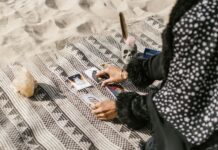
On May 16, ASPB presented “Tattoo Taboo,” an event on tattoo stigma and identity. The event featured Kip Fulbeck, an author, spoken word performer and affiliate faculty of Film & Media studies and Asian American Studies at UC Santa Barbara. Fulbeck has authored several books such as “Permanence: Tattoo Portraits” and “Part Asian, 100% Hapa.” Fulbeck has also directed a few short films such as “Banana Split.”
Before the event, ASPB asked UCR students to submit pictures of their tattoos and the stories behind their tattoos. The stories and pictures were showcased at the event. While a few students got their tattoos for fun, many were heartfelt and touching, such as the cancer awareness and tattoos symbolizing the loss of a loved one. Other fun tattoos included a Haunter and Cubone tattoo one student got as an homage to Pokémon.
Fulbeck started off the event by stating that he wouldn’t consider himself an expert on tattoos, but rather an expert on identity. “Everyone has some form of identification to prove who they are, whether it’s their driver’s license or their school id card; tattoos are just another way to identify yourself,” said Fulbeck. He continued to say that everyday people make conscious decisions about how they want to portray themselves. People view how they style their hair or how they compile their outfits as expressions of their identity and, similarly, tattoos are another form of expressing one’s identity.
Tattoos are much more than an image—for many they also represent stories and personal histories, be they simplistic or emotional. In Fulbeck’s book “Permanence: Tattoo Portraits,” many people from all over the nation are shown with their tattoos and a handwritten and very personal note describing their tattoo. Fulbeck told the audience about his process when creating the book, and also shared stories of some of his encounters with the people photographed.
One particularly compelling story he told was when he approached men he described as “gangsters” in order to get them to contribute to his book. Thinking that his friend knew them, Fulbeck walked straight into a group of men who appeared to be threatening, only to find out that his friend didn’t know them. He then realized that the situation could be slightly risky, but began telling them about his book and asked if he could use their tattoos. They welcomed him with open arms, treated him like an old friend and even invited him to their barbecue later that night. Fulbeck told the story to prove that although many are feared or stigmatized for their tattoos, tattoo bias is often unjust.
For his book, Fulbeck also photographed some of the most famous people in both the tattoo and music industry today. His book features Kat Von D, Grime, Oliver Peck and Horiyuki as well as well acclaimed music figures like Paul Stanley, Slash and Johnny Winter.
Fulbeck continued his presentation by teaching the audience about Japanese tattoos and the culture behind them. He explained that tebori is a traditional Japanese hand tattooing, as well as the process a horishi (tattooer) goes through to create a beautiful, organic horimono (tattoo). All of this knowledge and information stemmed from his own personal experience.
Fulbeck has many tattoos himself spread across his back and both of his arms are covered, which he had done in Japan and at State of Grace tattoo shop in San Jose, CA. Some were done by artist and friend Horitaka, a well known practitioner of tebori and a previous apprentice of tattoo master Horiyoshi II.
At the end of his presentation Fulbeck answered a few questions from the audience. When asked about growing tattoo popularity and tattoo longevity, Fulbeck responded that he sees tattoos being around for awhile and that people will continue to get them. He believes that it is not specifically due to growing trends, but rather people get them because they want to. He was also asked whether or not he sees tattoos being accepted into corporate America, or business in general. To that Fullbeck said that he definitely does not see it being accepted in Japan, because there it is associated with the Yakuza, but in America possibly, depending on the area and the growing rate of tattooed Americans.
Fulbeck will continue his work on identity and tattoos. Fulbeck is workng on developing a tattoo project with tattoo artist Horitaka, which is set to debut in 2014 at the Japanese American National Museum in Los Angeles.








